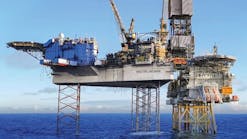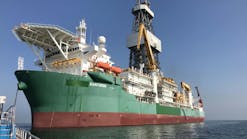Drilling services specialist Dietswell aims to finalize the full FEED for a new tender-assist drilling rig concept in 2012. The Paris-based company is working on this program in cooperation with various interested West Africa and Asia-Pacific region operators, including Total, PTTEP, and PetroVietnam.
The Horse Shoe Rig (HSR) is a column-stabilized semisubmersible, designed to reduce rig-up time and costs associated with tender-assist drilling alongside a wellhead jacket, mini-TLP or spar. Its hull is optimized for operations in severe environments, for instance in the Gulf of Guinea or Southeast Asia.
Dimensions of the rig include an overall length of 82.5 m (270 ft); a length and breadth of the main deck of 64 x 54 m (210 x 177 ft); a main deck elevation of 25 m (82 ft); an operational displacement of 18,300 metric tons (20,172 tons); and an operating draft of 12-15 m (39-49 ft).
According to Dietswell, a growing requirement for tender-assist operations is a heavy crane to reduce the number of packages to be transferred from the rig to the drilling platform. The HSR takes this a step further, by transferring an entire derrick set, via a single-lift operation, onto the platform.
The rig's U-shape allows it to surround the platform on three sides while undertaking this task. The elevation system, incorporating passive heave compensation and a fast ballasting device, allows the transfer to be effected without transmitting any loads onto the platform structure. To accommodate the footprint of the platform, the elevation system is also equipped with two beams with retractable ends.
This one-stop approach could save several days in rig-up/rig-down time, Dietswell claims, compared with normal operations using a tender-assist barge. Reducing the number of lifts should also lead to enhanced safety. Other advantages claimed for the HSR are increased living quarters capacity (up to 140 personnel) and larger mud tank capacities.
The HSR's capabilities and variable loads are derived from the requirements of a standard tender-assist rig, such as Keppel's SSDT 3600 design or the Frigstad T60. Originally, says Dietswell CEO Jean Claude Bourdon, the concept was designed for use with an eight-line mooring system in shallow waters, but now its range is being extended to deepwater application (up to 1,500 m, or 4,921 ft).
"We also want to have the unit performing multi-purpose tasks, including subsea intervention. This could be achieved by adding dynamic positioning, with heave compensated cranes providing lift capacity of 200 metric tons [220 tons] or so. The slot in the rig could be used for subsea tree maneuvers. There is a big need for this type of capability, particularly in deepwater operations offshore Angola."
More Offshore Issue Articles
Offshore Articles Archives
View Oil and Gas Articles on PennEnergy.com




